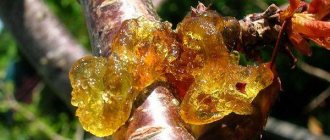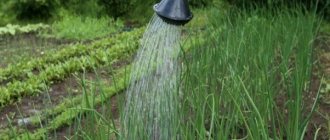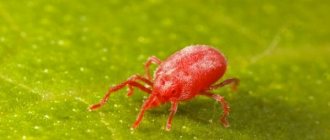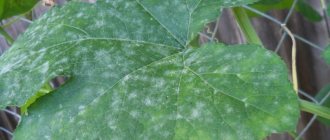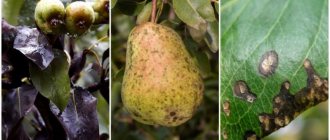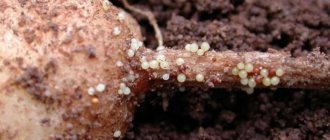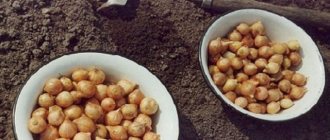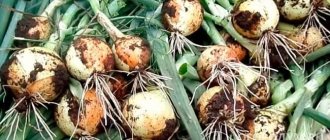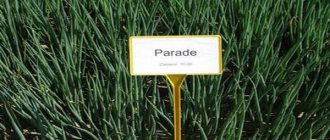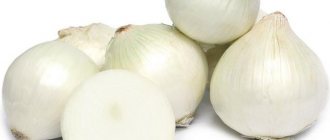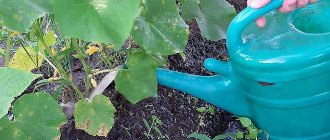Various diseases and pests cause enormous damage to onion plantings (as well as to another wonderful root crop - garlic) in the country. That is why preventive measures must be applied for this crop and the rules of agricultural technology must be observed. If we detect symptoms of any disease on vegetables or the appearance of pests, be sure to treat the onion planting (here about its cultivation) with special preparations.
This plant is attacked by numerous pests. Most often it is besieged by insects such as onion flies, root mites, and secretive beetles. To combat them, onions need to use modern insecticides. We protect garden beds from flying insects with materials such as spunbond. They cover plantings of vegetables during the summer of various pests. You should also always remove weeds and plant debris regularly.
Downy mildew
The fungal disease downy mildew spreads favorably after prolonged rains or when watering rules are not followed.
The affected feathers of the vegetable look sluggish, drooping, and lose color saturation. Gradually, the leaves become covered with brown-yellow spots, dry out and the plant dies. Preventive measures to combat the disease are:
- vegetable beds need to be weeded;
- In the fall, they begin to prepare the land allocated for planting onions: they dig up, apply fertilizers, and disinfect;
- seedlings can be sprayed with a solution of Bordeaux mixture;
- in rainy, cool summers it is useful to treat vegetable beds with biological products such as Fitosporin, Planriz, Gamair.
To disinfect the soil, you can use a solution of copper sulfate, Fitosporin, Alirin, Gamair, Baikal-Em. You can treat onions to remove powdery mildew with such products as Thanos, Ridomil, Vectra, Topaz.
The fungus that causes peronosporosis is carried by plant bulbs. Through the vessels, its spores penetrate into the feathers and 3-4 weeks after the appearance of the first feather, pale green spots appear, which in humid weather become covered with purple mucus with a greenish tint. Leaves affected by the fungus quickly die, and this has a detrimental effect on the formation of the turnip.
The onion disease downy mildew (downy mildew) has been known for a long time. The causative agent, the fungus Peronospora destructor Casp, was first discovered and described in England in 1841. Decades later, it struck Europe and the vast British colonies, from America to Australia.
For a long time, the harmful microorganism was encountered sporadically in eastern Europe, until an “epidemic” of the disease occurred in 1965-66. At that time, downy mildew affected half of all onion plantings in Ukraine and Kuban. A new wave of distribution swept in the 70s. Now downy mildew is observed annually in all growing areas, especially in the southern regions.
All types of vegetables are susceptible to this onion disease: onion, family, and trumpet are regularly affected. Chives, Altai and Beijing - only in years of epiphytotics (epidemics). Powdery mildew has become not only a common, but also the most harmful disease. It leads to a reduction in the size of the affected heads and delays their maturation. Attempts to develop varieties that are not susceptible to downy mildew were unsuccessful. Among the fairly stable specialists Fr.
The disease is accompanied by stages, which can be distinguished by characteristic symptoms:
- The first sign of green onion disease is the appearance of a brownish-purple velvety coating on healthy leaves.
- Over time, the spots increase in size and first become pale yellow and later brown.
- Over time, the spots become necrotic, which leads to the death of leaf tissue. The affected shoots have a yellowish-pale color and, like the leaves, are often colonized by other fungi Alternaria, Stemphilium, etc.
downy mildew of onions - in the photo
We prepare the first two like this - dilute 40 g of the drug per 10 liters of liquid and spray the stems two or three times at intervals of 10-12 days. Polycarbacin does not leave burns on the leaves of the plant and is low-toxic, but the last treatment should be carried out no later than 20 days before harvesting the onion. In addition, onions treated with Polycarbacin cannot be cut into feathers.
You can make 1% Bordeaux mixture by adding 100 grams of copper sulfate and 100-150 grams of slaked lime to 10 liters of water. Ridomil Gold should be used in several stages - when the first warm days of April appear, and in May, when powdery mildew is most likely to appear, for preparation, dilute 25 g in a bucket of water.
Downy mildew of onion, folk control measures:
- Chop any weeds growing in the garden and fill the bucket halfway with them, add hot water 60 ° ... 70 ° C, let it brew for 2 days, strain and spray onion
- Pour onion peel (250 g) into 10 liters of water, boil, let it brew for 2 days, and treat the plantings at intervals of 7-10 days
- Pollinate the beds with wood ash at the rate of 50 g per 1 m²
downy mildew - in the photo
Observe safety precautions when using fungicides and do not forget to wash the product before use. Prevention of peronosporosis:
- process planting material
- remove weeds and plant debris
- remove fallen stems
- plant onions in a warm and ventilated area
Stem nematode
Stem onion nematode is the most dangerous enemy. She is amazingly resilient. These small worms are capable of hiding in the ground at a depth of up to 1.5 meters and then crawling out to the objects of attack; they are not afraid of frost and can live at a constant temperature of + 2 °C in a vegetable store, continuing to infect bulbs. Without food, nematodes survive for 18 months or go into suspended animation, and can survive up to 20 years, and then continue their activities. The female is capable of laying 400 eggs in her life of 30–40 days.
Symptoms
Stem nematode is a pest of many vegetable crops. It causes serious damage to onions by sucking out the sap of the plant. This pest can live 3–4 years. At first they live on plants, then they go into the ground. Heavy soil and high humidity are the most favorable conditions for this parasite.
The first leaf of the affected plants appears at the beginning of the growing season - the feather is slightly thicker and crooked. Subsequently, the leaves droop and turn yellow. Inside the bulb, the scales soften and rot. The bulb is soft to the touch.
Advice! Such bulbs are unsuitable for consumption and storage! Even if you decide to cut off the darkened scales and use the white ones for cooking, don’t do it!
One such bulb can contain up to several thousand worms! You can only see them through a strong magnifying glass if you cut the onion into 3 mm pieces and fill it with water so that the level is no more than 5 mm for an hour while examining the water.
Treatment and prevention
There is still no remedy that would destroy the stem nematode. And all the products are poisonous, and they need to be processed repeatedly. So it all comes down to prevention.
Healthy planting material is very important in the fight against this infection!
- Proper storage of onions and onion sets.
- Crop rotation. No earlier than four years, plant onions and garlic in the same place.
- Before planting, add urea to the ground or sprinkle with ammonia (3 tablespoons per 10 liters of water).
- Planting time also plays an important role. Onion seeds should be planted or sown as early as possible so that the temperature is lower.
- Cultivate the land. Add sand and peat under the plantings to make the soil as light as possible, which the worm does not like. And it’s good to add dolomite flour or lime when digging, deoxidizing the soil.
- Process planting material. The onion sets need to be carefully sorted, dry scales should be trimmed with scissors, and loose layers should be peeled off.
Advice! You can deoxidize the soil with soda. To do this, dissolve 10 g of soda in a bucket of water and pour over the beds, or pour 100 ml into each hole.
How to treat onions for pests before planting?
Take a container with hot water at 45–47 °C and pour all the seeds into it. While it warms up, and this temperature is harmful for many pests, dilute 1 tablespoon of birch tar in 1 liter of water. For this, also pour warm water. Pour this mixture over the sevok. Leave for 4 hours.
This wonderful product with a strong smell will repel many pests, plus the prevention of fungal diseases. After such a bath, the onions are ready to plant!
Onion diseases and their treatment
The disease is caused by a bacterium in the soil that affects the tops of the plant and leads to the death of the feather along the entire length, as well as to the rotting of the turnip, the bulb becomes softer and more watery, and characteristic rot of the bottom of the onion appears. The causes influencing the occurrence of the disease are:
- excess moisture in the soil
- late harvest
- poor quality planting material
- the growing season takes place in hot weather
onion fusarium - in the photo We invite you to read: Characteristics and description of tomato variety Thumbelina
Carry out preventive measures while preparing the soil for planting. Use chemicals for soil treatment - 2% Iprodione (use according to instructions), TMTD fungicide will disinfect the soil and seeds, prepare a suspension in equal parts of water and the drug, not compatible with drugs containing copper. 0.5% disinfects the soil (dilute 50 g of the substance in 10 liters of water).
Follow the rules to prevent fusarium onion:
- disinfect planting material (potassium permanganate solution, Fitosporin)
- use early and early ripening onion varieties
- treat the soil before planting (the techniques are listed above)
- alternate onion planting sites
- loosen and weed the beds
- harvest in a timely manner
The disease may appear after harvesting and spread to healthy bulbs, observe storage conditions - place the onions in wooden boxes, the room must be ventilated, constant temperature 5 ° C, air humidity 60%.
Neck rot of onions - pictured
- excessive moisture and lack of sun
- poor quality planting material
- insufficient disinfestation of soil and raw materials
- harvesting onions in rainy weather
- insufficient feeding of the plant
At the first suspicion of a disease, you can use 1% Bordeaux mixture (dilute 100 g of the mixture in 10 liters). The drug Quadris is used both in the treatment of planting material and for the treatment of fungal diseases in the garden. Preparation: dilute 8 ml of the drug in 10 liters of water. Prevention of the appearance of cervical rot:
- weed cutting
- loosening the soil
- harvesting ripe crops in dry weather
- drying the bulbs for 7 days at 35° C (after collection)
- storage in a disinfected room at 3° C and humidity not higher than 70%
Caused by bacteria that damage an already harvested crop, but sometimes the plant becomes infected in the soil. Externally, the onion peel looks wet, then the inside becomes loose, sticky to the touch when pressed, moisture with an unpleasant odor is released.
Reasons for appearance:
- increased soil moisture
- contaminated soil
- incorrect storage conditions
- crop damaged during harvest and by insects
black rot of onions - in the photo
Prevention:
- disinfection of planting material and soil
- fight against onion fly, the vector of the disease
- maintaining the integrity of the onion head
- harvesting in dry weather
- drying bulbs
- compliance with storage rules (listed above)
To save the harvest in a rainy summer, experienced summer residents and gardeners recommend trampling onions before harvesting. Why, you ask? So that the bulbs do not become saturated with excess moisture and have the opportunity to ripen by the time the onion harvesting begins. If you pull out an onion, you will see that it is growing and is not going to ripen, while the feathers are green.
The causative agent is a fungus that infects vegetables during storage, expressed by drying out of onion skins and the appearance of green (penicillium) mold on the bottom and side parts of turnips, most often appearing after the second or third month of storage. Causes of green moldy rot:
- mechanical damage during harvest
- high humidity in the room where onions are stored
Harvest carefully to avoid damaging the bulbs. You can use preparations against small pests (mice) to keep the vegetables intact. Maintain a temperature of 3° C and a humidity of 60% in the room where the onions are stored.
Now you know the most common onion diseases, descriptions and their treatment, good harvests to you!
Fusarium onion blight is less common than downy mildew. It appears both during the growing season and in storage. During the growth period, fusarium wilting of onion leaves occurs, and during storage, characteristic rot of the bottom of the bulbs occurs. The disease is most often recorded at the end of the growing season. Characteristic features:
- Premature yellowing, curling and dying of leaves, starting at the crown.
- Subsequently, the disease spreads to the entire leaf blade, the leaves wither and rot. Infected parts of the bulb turn brown.
- Sometimes, due to a lateral lesion, the healthy half grows, and the infected half curls and is pressed in - the disease gives the bulb a concave-convex shape.
One of the most dangerous diseases of onions during storage, and sometimes during the period of growth and harvesting. The disease begins soon after harvest - with softening of the scale tissue, usually at the neck of the bulb, especially in places of mechanical damage. The affected areas look like depressed “cooked” spots and gradually cover the surface of one or more scales.
We suggest you read: Cotton pads are inserted into the nasal passages
They are brown, watery, and over time such areas die off and become porous, like a sponge. A gray mass appears on the infected tissue (between the scales), and a black mass of small sclerotia may form on the outer tissue (around the neck). The area of infected tissue enlarges, spreading down the scales.
The bulb is affected only through damaged areas, almost always at the neck, which is why this disease is also called neck rot. Most often, rot penetrates the tissue during harvesting, when the leaves of unripe and poorly dried bulbs are cut too low. Specimens that are infected with downy mildew are more susceptible to gray mold.
The causative agent of onion disease is most often the bacterium Erwinia carotovora Bergey, which can cause vascular and parenchymal lesions. The source of infection is contaminated soil and affected post-harvest onion residues. Bacteria are spread by splashing raindrops, irrigation water and insect pests. Sometimes other bacteria also cause bulb rot: Pseudomonas aeruginosa, Pseudomonas gladioli and others.
Microorganisms cause soft rot diseases of various organs. In affected bulbs, a large light or slightly pink spot forms around the stem end. The tissue softens and becomes covered with mucus. In such heads, the first outer layer of scales is healthy, and the next ones become yellow-brown. When severely damaged, the tissues soften, emitting an unpleasant odor.
Unfortunately, today there are no reliable mechanisms to prevent the development of epiphytoties (epidemics). Scientists are constantly searching for means to suppress the activity of microorganisms in order to obtain full onion yields. During the growing season, fungicides are applied at the first signs of infection. The effectiveness of any pesticide used, its application rates and frequency of treatments largely depend on the development of the disease.
How to treat onions against diseases? In the 20s, Bordeaux mixture was used (it is still relevant now, especially in private farms), and then substitutes appeared - zinc-containing contact fungicides. Based on them, a system of chemical protection measures against peronosporosis has been developed. Contact fungicides, effective at high application rates, were previously used to protect onions. In the 80s, they began to use systemic drugs that were highly effective at the initial stage of use.
- For powdery mildew: “Quadris”, “Ordan”, “Alirin-B”, “Revus”, “Bravo”, “Abiga-Pik” and others (according to the instructions).
- For gray and cervical rot: “Quadris”, “Bravo”, “Ridomil Gold”, “Switch” and others.
However, constant treatment of vegetative plants with systemic fungicides can lead to the emergence of resistant strains of pathogens and reduce the effectiveness of the drugs.
When growing onions, gardeners and large farms are faced with the emergence of various crop diseases that jeopardize the future harvest. To combat them, it is better to use an integrated approach, which involves treating plantings with special preparations and implementing appropriate agrotechnical practices.
The causative agent of cervical rot is a fungal infection. Often the disease affects unripe bulbs or crops that have been in wet soil for a long time.
A characteristic sign is softening of the neck of the bulb, its thinning and rotting. A gray fluffy coating and an unpleasant odor appear. Gradually, the plaque turns into small black grains that merge with each other. If you do not start fighting the disease, plaque covers the entire bulb.
If you plant infected bulbs, then in the future the feathers will grow weak and pale green. The inflorescences do not reach the ripening stage, become covered with mold and the heads drop down.
The main agrotechnical measures to combat the disease are:
- For planting, you need to choose fungus-resistant varieties;
- after harvesting, the site is cleared of all waste;
- weeding and watering the beds are carried out carefully, without damaging the feathers;
- do not overdo it with nitrogen fertilizers;
- You need to harvest in dry weather, drying the collected bulbs for at least two weeks;
- The leaves of the harvested onions do not need to be cut too short; it is recommended to leave a stump of 3–4 cm.
- Only whole, large and dense heads, without damage, are selected for storage;
- It is advisable to treat planting material with special solutions.
Prevention
Preventive methods of disease control will allow you to get a good harvest of green, onion, green mass of perennial onions, and high-quality seed material.
The main rule of prevention is correct crop rotation. Onions can be planted in one place every 4-5 years. This will allow the soil to be disinfected by planting other plants, which will reduce or destroy populations of fungal pathogens.
For a month and a half, the onions are heated at a temperature of 40°-50° for 8 hours. If the bulbs are large, then the time increases to 24 hours. A week before planting in open ground, the onions are pickled in a solution of potassium permanganate (some recommend a slightly pink solution, others recommend a dark pink solution), washed in running water and dried.
- Proper planting of onions is very important, as very close plantings can make plants more vulnerable to disease.
- Onions love the sun and fresh air, so it is advisable to make beds in the north-south direction for better illumination and plant onions less often for an influx of fresh air.
- This will provide additional onion resistance to disease.
Proper watering is the key to an excellent onion harvest
Since the main cause of almost all onion diseases is excessive soil moisture, it is important not to overdo it with watering. Water the onions 4-6 times during the summer and be sure to loosen the dried top layer of soil
And during the ripening of the bulb and before harvesting, watering is stopped altogether, since excessive moisture will cause problems during storage.
Cleaning and drying
Since most onion diseases appear during storage, it is important to properly harvest and prepare the crop for storage.
It is better to choose dry weather for harvesting, since rainy and humid weather provokes the development of fungal diseases. You need to dry the bulbs in an open place in sunny weather and under canopies in rainy weather. The main thing is to provide access to fresh air. When transporting, you need to handle the bulbs as carefully as possible, since any mechanical damage provokes rot.
Such preventive measures will prevent many onion diseases and thus preserve the harvest. If prevention did not help or it was not possible to follow the rules of agricultural technology, preparation for storage or storage itself, then you will have to use methods to combat diseases that have affected the plants.
Onion rust
Signs of infection by the fungal disease rust include wilting, drying and yellowing of the leaves. The bulb is formed in small sizes and is poorly stored. Orange-yellow or brown-reddish tubercles appear on diseased leaves. Gradually the feathers begin to die off.
Fungal spores tolerate cold well and overwinter on plant debris. That is why it is recommended to remove the remaining tops from the garden at the end of the growing season. The development of rust is also promoted by cool, rainy summers, too dense plantings and an excess of nitrogen in the soil.
We invite you to familiarize yourself with: Tomato apple tree of Russia characteristics and description of the variety
What to do if the feathers become coated and other signs of rust appear? Most often, the disease develops at the end of summer, so it is important to inspect your plantings daily. If a problem occurs, you need to stop watering the beds and applying nitrogen fertilizers. Damaged stems are cut off and removed away from the site.
If signs of disease are detected, the vegetable crop should be treated with fungicides. Folicur, Ordan, Topaz are considered effective. The drug Hom, Tilt or simple Furacilin cope well with the disease.
The disease is caused by a fungus that spreads well in a humid environment and affects the stem and growth of turnips, so it is advisable to eradicate it immediately. The disease, onion rust, is expressed by bright orange-yellow swollen spots, round in shape, which then turn into black dots. The reasons for the appearance include early planting, densely planted beds, an abundance of weeds and excessive watering.
It is worth noting that the fungus only eats into a wet leaf; it will not penetrate into a dry feather. If onion plantings are exposed to rain for a long time, fungal spores quickly germinate and take root. If the onion is sick, most likely the currants and other shrubs will be affected by the disease. Due to the fact that diseased feathers do not work well, the yield is reduced.
rust using garlic as an example - in the photo
Prevention of the disease:
- treat planting material with bactericidal agents (for example, potassium permanganate solution)
- plant varieties resistant to the disease (Sprinter)
- fight weeds and remove plant debris from the beds
- cut off damaged stems and burn
- do not plant onions too thickly
During the period of massive growth, onions should be sprayed with copper oxychloride. To prepare the solution, take 30 grams of the substance, the same amount of liquid soap and dissolve it all in a bucket of water. The treatment must be repeated after 7-10 days. It is better to carry out processing during the day so that the feather has time to dry. Hom, Tilt and even furatsilin cope well with rust (10 tablets need to be diluted in a liter of water).
Onion rust appears at the end of April; if you notice the first signs of the disease, stop watering the plant and fertilizing it with nitrogen fertilizers, and get rid of damaged stems. Perennial onion species are most susceptible to the disease, and their treatment is also urgent.
Onion rust is caused by a fungus that grows on the feathers. It settles into dark yellow pads that are attached to the leaves. From a distance they resemble rust. The disease is contagious and progresses rapidly, stopping the growth of both leaves and bulbs.
Measures to combat downy mildew
- Compliance with garden crop rotation with the return of onions to their original place only after 3–4 years. Otherwise, the infection accumulates in the soil and the likelihood of plants becoming infected with the disease increases significantly.
- Onion plantings should be located in sunny, open, ventilated areas with light sandy loam and loamy, fertile, weed-free soils. The area should be ventilated with good drainage. All measures should contribute to the rapid drying of plants: avoid watering at night, destroy weeds.
- Good predecessors are pumpkin crops, cucumbers and cabbage, for which large amounts of organic and mineral fertilizers are applied.
- The use of healthy planting material and spatial isolation of plantings of perennial onions (onions, shallots, etc.) from onion fields reduce the intensity of infection.
- Cultivation of relatively disease-resistant varieties and hybrids - Antey, Kasatik, Kachinsky, Odintsovets, Stimul, Stuttgarten Riesen, Ellan, etc.
- Disinfection of seeds, cultivation of resistant varieties.
- Planting material (seeds, turnips, selections) obtained from crops affected by downy mildew must be warmed up. This is done in the fall before the end of drying. The mycelium of the pathogen located inside the bulbs is killed by heat treatment for 8 hours at a temperature of +40°C.
- Warming up the onion sets before planting at a temperature of +40+42°C for 8–10 hours.
- Avoid thickening the onion plantings and preventing the beds from becoming clogged with weeds.
- If the disease appears, avoid fertilizing the plants with nitrogen fertilizers, mullein and watering. Don’t forget about potassium and phosphorus, they increase the resistance of onions to downy mildew.
- To prevent the disease when the leaves are 10–12 cm high or when the first signs of the disease appear, spray the plantings with a 1% solution of Bordeaux mixture. You can use a suspension of copper bleach or “Polycarbacin” (40 g of the drug per 10 liters of water), “Artserida” (30 g of the drug per 10 liters of water). To ensure that the solutions used are better retained on the plants, it is advisable to add 1% skim milk or soap to them. The consumption rate of the working solution is 1 liter per 10 sq.m. The treatment can be repeated after one and a half to two weeks.
Attention! Bordeaux mixture can be used no later than 2 weeks before harvesting, the rest - 20 days. Onions sprayed with Bordeaux mixture or Polycarbacin should not be used on green feathers.
Pollination of onion plantings with sifted wood ash (50 g per 1 sq.m.). After 5–7 days, this pollination must be repeated.
To combat powdery mildew, you can use any garden weeds from which fermented grass is prepared. To do this, fill 1/2 a bucket of finely chopped weeds to the top with hot water, mix and leave for several days, then strain through cheesecloth and use for spraying.
A very good recipe is prepared on the basis of spoiled fermented milk products (sour milk, kefir or yogurt). The lactic acid bacteria that develop in these products act on the pathogen of this disease and at the same time do not harm the plants.
The spray preparation is prepared from separated fermented milk whey, it is diluted in a ratio of 1:10 with cold water and mixed until a homogeneous solution is obtained. The prepared solution is poured into a sprayer and the plants are treated.
- Harvest the bulbs in dry weather at the very beginning of lodging of the leaves, when they are still green. Leaves should be cut off and burned immediately.
- Drying the bulbs until they are completely dry and dry covering scales form.
Since downy mildew on onions is a disease that has an explosive spread, the most effective tactic of protective measures is to carry out preventive (before the appearance of visual symptoms) treatments with fungicides.
Fusarium
Common onion diseases include the fungal disease Fusarium. The appearance of the first signs is indicated by yellowing and wilting of the leaves. Initially, the tops of the feathers are affected, gradually rotting spreads along the entire length of the leaves. The bulb itself often rots. It becomes watery, softens and smells unpleasant. A pinkish fungal coating forms on the bottom of the bulb.
Provoking factors are excess moisture in the soil, untimely harvesting, poor-quality planting material, and too dense planting.
Proper preparation of soil and seed material is considered preventive control measures. It is recommended to treat the soil with copper sulfate or a preparation such as Iprodione. Disinfection of planting material is carried out with a solution of the drug Fitosporin, Quadris or Fundazol, which can be soaked in a weak solution of potassium permanganate.
If signs of disease are detected, it is necessary to remove the affected plants from the garden and burn them, and treat the remaining vegetables, for example, with Fitosporin.
Green mold rot
Green mold rot affects already harvested crops during storage. The onion skin dries out and becomes covered with green mold. The main reasons are: damage to the bulbs during harvest and high humidity in the room where the crop is stored (more than 70%).
Onion pests often cause the development of the disease. Even in the beds, they introduce infection into the plant, and under favorable conditions, pathogenic microorganisms begin to actively develop, leading to rotting of the crop.
Watery brownish spots appear on infected bulbs near the bottom. After some time, an unpleasant smell of mold appears from them, and a greenish coating is observed under the scales.
Preventative measures include careful drying of the crop and compliance with all requirements for its storage. The room should be dark, cool (about +3 degrees) and not damp. Pre-disinfect the onion storage area.
It is recommended to select bulbs in advance for planting next year. Advice: remove the seed material for storage in another place. Check it periodically and get rid of diseased and damaged bulbs in a timely manner.
Black mold rot
Fungal disease black mold rot is a problem mainly of already harvested crops that have been put away for storage. Diseased bulbs become soft, rot, become deformed, the scales dry out and become covered with a black coating. But you can notice signs in the garden. Fungal spores infect leaves when they are wet for more than 7 hours.
The development of the disease is provoked by improper storage conditions. Black mold on onions develops in musty, damp rooms where there is high humidity, large temperature fluctuations and poor air ventilation. The disease is provoked by insufficiently well-dried crops after digging out of the soil.
The protective measures are:
- when loosening and weeding the soil, care must be taken not to damage the leaves, otherwise the wound may become a site of infection;
- The harvested crop should also be protected from damage;
- maintain low air humidity and low temperature in the room;
- remove old plant tops from the garden bed;
- Since onion pests cause disease, there is no need to allow them to appear in the garden.
Harvesting must be done in a timely manner. You cannot remove unripe or overripe onions. It will be poorly stored and there is a high risk of developing various diseases.
Useful ingredients at any time of the year
In the winter months, when the amount of beneficial components in fruits and vegetables decreases, human health will be supported by the most common onion. You can consume onion juice, which contains a huge amount of vitamins, microelements, proteins, sugar, essential oils and alkaloids. The solid parts contain fiber that is useful for digestion, which makes the intestines work intensively.
Enzymes and bioactive components normalize metabolism, phytoncides kill bacteria. Folic acid is necessary for normal cell development; if it is deficient, anemia develops. In order for the blood composition to be normal, it is necessary to eat onions during pregnancy, illness and poor health. Return to content
